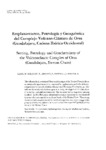Mostrar o rexistro simple do ítem
Emplazamiento, Petrología y Geoquímica del Complejo Volcano-Clástico de Orea (Guadalajara, Cadena Ibérica Occidental)
| dc.contributor.author | Lago San José, M. | |
| dc.contributor.author | Gil-Imaz, A. | |
| dc.contributor.author | Arranz Yagüe, E. | |
| dc.contributor.author | Bastida, J. | |
| dc.contributor.author | Pocovi, Juan A. | |
| dc.date.accessioned | 2010-01-22T13:23:12Z | |
| dc.date.available | 2010-01-22T13:23:12Z | |
| dc.date.issued | 1995 | |
| dc.identifier.citation | Cadernos do Laboratorio Xeolóxico de Laxe, 1995, 20: 195-212 ISSN: 0213-4497 | es_ES |
| dc.identifier.issn | 0213-4497 | |
| dc.identifier.uri | http://hdl.handle.net/2183/6189 | |
| dc.description.abstract | [Abstract] The volcanoclastic outcrop ofOrea (south margin of the Iberian Chain) reflects a pluriepisodic igneous activity, expressed in agglomerates and tuffs ofdacitic composition (with a calc-alkaline affinity) and Autunian-Thuringian age. The tuffs are the results' of a hydromagmatic activity, developed under a thin sheet of water (in a paludal environment). The structure of the magmatic outcrop results of the late-Hercynian extensional tectonics, equivalent to that observed in many other outcrops ofthe southeast border ofthe Iberian Chain. The setting characters and composition of the involved magmatic rock-types, suggest the presence of only one volcanic focus, as in other coetaneous half-grabens of this sector of the Iberian Chain. | |
| dc.language.iso | spa | es_ES |
| dc.publisher | Universidade da Coruña | es_ES |
| dc.title | Emplazamiento, Petrología y Geoquímica del Complejo Volcano-Clástico de Orea (Guadalajara, Cadena Ibérica Occidental) | es_ES |
| dc.title.alternative | Setting, Petrology and Geochemistry of the Volcanoclastic Complex of Orea (Guadalajara, Iberian Chain) | |
| dc.type | info:eu-repo/semantics/article | es_ES |
| dc.rights.access | info:eu-repo/semantics/openAccess |






